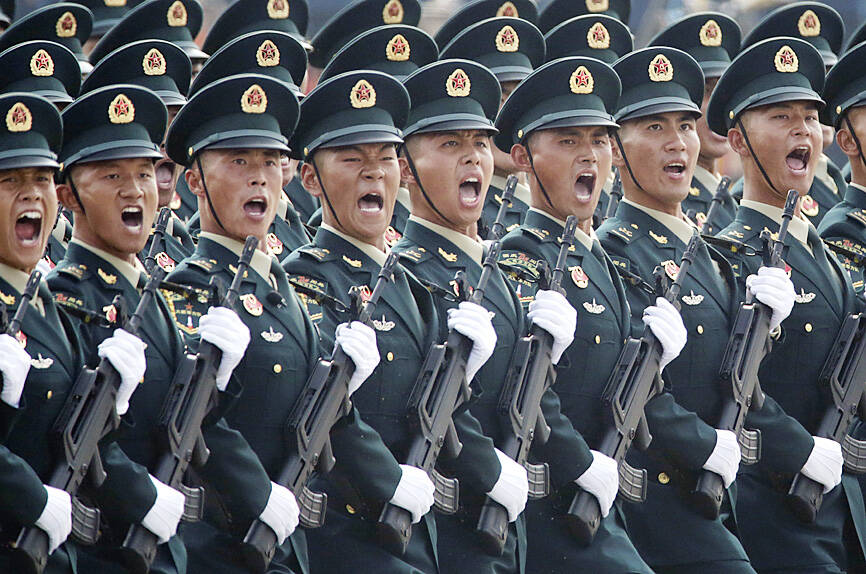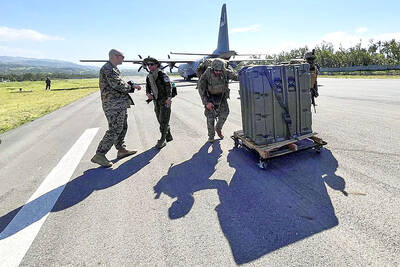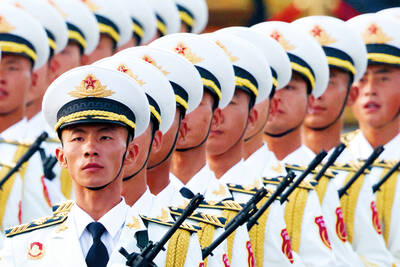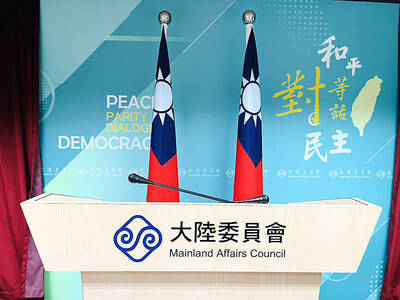The Chinese military has boosted its capability to fight at a high tempo using the element of surprise and new technology, the Ministry of National Defense said in the Quadrennial Defense Review (QDR) published on Monday last week.
The ministry highlighted Chinese People’s Liberation Army (PLA) developments showing significant changes in Beijing’s strategy for war on Taiwan.
The PLA has made significant headway in building capabilities for all-weather, multi-domain intelligence, surveillance, operational control and a joint air-sea blockade against Taiwan’s lines of communication, it said.

Photo: Jason Lee, Reuters
The PLA has also improved its capabilities in direct amphibious assault operations aimed at seizing strategically important beaches, ports and bases, and has combined novel and conventional technology in multiple layers, it said.
It has worked on enhancing the cooperation between military and civilian society to enable a rapid transition to a wartime footing, it said, adding that it continued to build its strategic weapons arsenal to deter international intervention in the Taiwan Strait.
China has been building navy and coast guard offshore patrol vessels en masse, which could be used to isolate important ports from strategic materials and commerce, the ministry said.
The PLA Navy could also be rapidly deployed to blockade or shape conditions for a formal attack on Taiwan proper, it said.
China plans to mobilize civilian transport vessels to assist military operations, which could resolve its lack of logistical capabilities, the ministry said, adding that it could conceal signs of an invasion preparation.
The PLA would be able to hide from prying eyes its transition to war and shorten the time Taiwan would have to prepare for a fight, it said.
Identifying the signs of a Chinese invasion has become difficult for Taiwan, the ministry said.
The prevalence of commercial satellites allows for unprecedented observation and geolocation capabilities that has made the battlefield transparent, it said.
The armed forces must be mobile, agile and capable of dispersing or concentrating as needed, to preserve its force under enemy fire, it said, adding that it must also focus on building flexible and agile capabilities to enable the rapid dispersal or concentration of combat power.
Long-range and uncrewed weapon systems allow precision strikes at longer ranges and give more choices in delivery, blurring the line between the front and rear areas, it said.
The protection of logistics lines has become key to winning offensive and defensive operations on a battlefield where troops are sure to consume huge amounts of ammunition and supplies, the ministry said.
The PLA’s electronic warfare combined with hard-kill capabilities pose a severe threat to the nation’s armed forces, it said.
The military must have secure communication, and geolocation and navigation systems to deploy and preserve combat power, the ministry said.
Drones, including “smart” loitering munitions, have brought significant changes to land warfare and air defense, it said, adding that uncrewed aerial and naval vehicles could be used to attack maritime targets or conduct long-range strikes.
China would use conventional, mixed and unconventional forces should a war break out, it said.
For Taiwan, mounting an effective defense depends on whole-of-society support, rapid mobilization of military and civilian capabilities, and ensuring the government and essential services survive, the ministry said.

Three batches of banana sauce imported from the Philippines were intercepted at the border after they were found to contain the banned industrial dye Orange G, the Food and Drug Administration (FDA) said yesterday. From today through Sept. 2 next year, all seasoning sauces from the Philippines are to be subject to the FDA’s strictest border inspection, meaning 100 percent testing for illegal dyes before entry is allowed, it said in a statement. Orange G is an industrial coloring agent that is not permitted for food use in Taiwan or internationally, said Cheng Wei-chih (鄭維智), head of the FDA’s Northern Center for

LOOKING NORTH: The base would enhance the military’s awareness of activities in the Bashi Channel, which China Coast Guard ships have been frequenting, an expert said The Philippine Navy on Thursday last week inaugurated a forward operating base in the country’s northern most province of Batanes, which at 185km from Taiwan would be strategically important in a military conflict in the Taiwan Strait. The Philippine Daily Inquirer quoted Northern Luzon Command Commander Lieutenant General Fernyl Buca as saying that the base in Mahatao would bolster the country’s northern defenses and response capabilities. The base is also a response to the “irregular presence this month of armed” of China Coast Guard vessels frequenting the Bashi Channel in the Luzon Strait just south of Taiwan, the paper reported, citing a

The Chinese military has built landing bridge ships designed to expand its amphibious options for a potential assault on Taiwan, but their combat effectiveness is limited due to their high vulnerability, a defense expert said in an analysis published on Monday. Shen Ming-shih (沈明室), a research fellow at the Institute for National Defense and Security Research, said that the deployment of such vessels as part of the Chinese People’s Liberation Army (PLA) Navy’s East Sea Fleet signals a strong focus on Taiwan. However, the ships are highly vulnerable to precision strikes, which means they could be destroyed before they achieve their intended

UNDER PRESSURE: The report cited numerous events that have happened this year to show increased coercion from China, such as military drills and legal threats The Chinese Communist Party (CCP) aims to reinforce its “one China” principle and the idea that Taiwan belongs to the People’s Republic of China by hosting celebratory events this year for the 80th anniversary of the end of World War II, the “retrocession” of Taiwan and the establishment of the UN, the Mainland Affairs Council (MAC) said in its latest report to the Legislative Yuan. Taking advantage of the significant anniversaries, Chinese officials are attempting to assert China’s sovereignty over Taiwan through interviews with international news media and cross-strait exchange events, the report said. Beijing intends to reinforce its “one China” principle